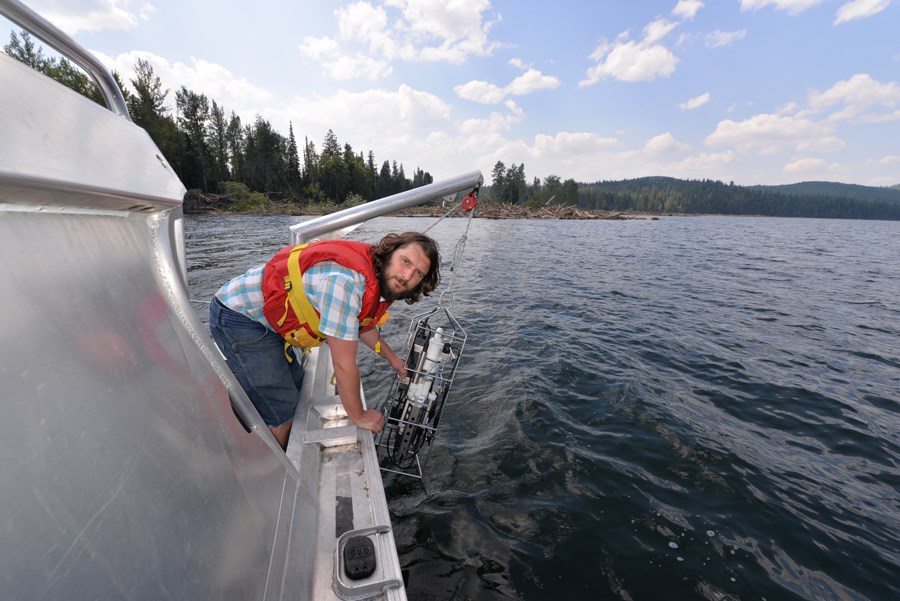The massive tailing pond spill at Mount Polley Mine raised water levels and temperature in Quesnel Lake, increased copper concentrations and spread a massive plume of fine sediment which remains suspended in the lake and is spreading into connecting streams, a new study found.
Researchers looked at three months of data following the August 2014 breach, which flushed 24-million cubic metres of water and waste into area waterways.
While some of the sediment from the open pit gold-and-copper mine has settled on the floor, much remains suspended as fine particles scoured from Hazeltine Creek.
Because the water in the lake rocks back and forth, it means the sediment is pushed in multiple directions, including towards the north and east arms of Quesnel Lake, which is a major sockeye salmon habitat, as well as towards the lake outflow, Quesnel River.
“The primary concerns are how far this material moves within this system because it’s a big watershed and it’s connected to the Fraser (River): how far does it move and how might some of the contaminants enter into the food chain?” said Phil Owens, one of the five co-authors of the study from the University of Northern British Columbia.
The persistence of the fine clay hanging in the water column was one of the few surprises to researchers.
“It’s not necessarily purely sediment from the tailing disaster; it’s what was scoured out of Hazeltine Creek,” said Owens Tuesday after the Geophysical Research Letters published the paper online.
The creek, which is still leaking sediment, used to be a couple metres wide and is now 50 to 150 metres depending on the location. It also used to be less than a metre in depth and that increased to 20 metres. It also caused the lake to rise by almost eight centimetres.
“It’s completely transformed,” he said.
Some areas of Quesnel Lake and Quesnel River show copper concentrations four times the recommended guidelines for freshwater ecosystems. In parts of Hazeltine Creek, that jumps to 10 times the recommended level, he said.
Researchers are paying particular interest to zooplankton – small organisms like water fleas that are considered the bottom of the food chain – for metals or other contaminants.
“That’s one of the early bellwethers that will tell us whether the metals are getting in the food chain,” said Owens, adding they’re seeing some early indications that might be happening but the data still needs to be assessed.
“It may take a little longer to see a signal in some of the salmon and some of the resident fish.”
“That’s how it starts to magnify through the food chain.”
The sediment, too could impact spawning and the viability of eggs if they are covered by the floating fine sediment.
A change in temperature can have an effect in two ways: the way the lake behaves – the way it overturns for example – or it can affect the behaviour of the organisms.
Luckily, the slight increase in temperature happened at the bottom of the deep lake, where the water is already quite cold.
“Salmon are very sensitive in the temperature range that they can experience. If you change that dramatically then that could have an effect. I don’t think that will be case here because it was a few degree change,” said Owens, in reference to the 1 to 2.5 Celsius rise. Copper, however, may have a bigger impact.
“You don’t actually (need) high levels of copper to make it affect how salmon behave in term of their ability to use their senses to identify where they’ve come from,” said Owen, citing research out of the University of Lethbridge.
“It can affect their movement and pathway, their key most sensory behavior. Their ability to use chemical smell and the like to navigate back to their spawning habitats,” he said.
That means following at least a couple salmon cycles, and studying the spill’s impact for potential long term impacts on the ecosystem.
“That’s why we think it’s vital to have comprehensive research going on there,” said Owens, who said some funding came from the Pacific Salmon Foundation but the research is primarily supported by UNBC.
“We thought there would be a lot more available funding,” said Owens, who called for more financial and logistic support.
“There’s a raft of things that really we need to look at.”
Researchers were lucky they were already monitoring the lake at the Quesnel River Research Centre and so could compare conditions before and after the spill using historic in-lake mooring data, newly collected data, data from the British Columbia Ministry of the Environment, Environment Canada and the Mount Polley Mining Corporation.
Owens noted the water quality has been a good news story for the spill.
Environment Minister Mary Polak said the study matches current and consistent clean water tests conducted by the government, but years of testing are necessary.
She said elevated levels of metals have been found in the lake, but so far there are no signs that the mine waste is dissolving into the water.
Polak said current testing indicates it’s safe to eat the fish from Quesnel Lake.
“It confirms what we’ve already found, and all those results are posted monthly and will continue to be posted monthly,” she said.
Vancouver-based Imperial Metals, which operates Mount Polley, said it could reopen the mine in June if granted a permit.
— with files from Canadian Press



